Brother MFC-J200 User Manual
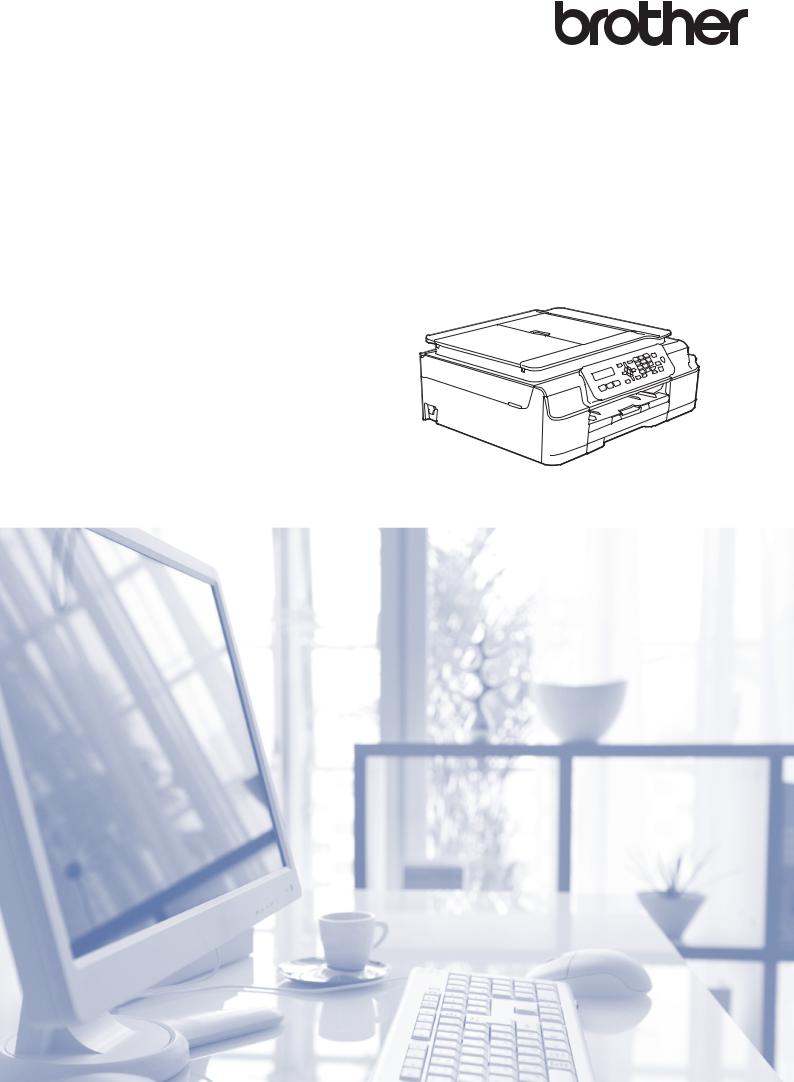
Basic User’s Guide
MFC-J200
Version 0
MEX/LTN-ENG
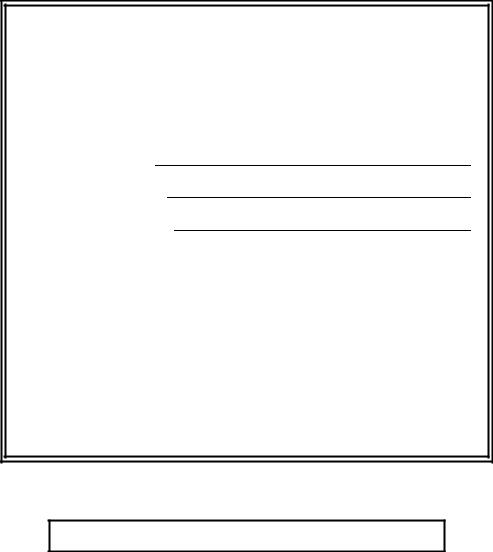
If you need to call Customer Service
Please complete the following information for future reference:
Model Number: MFC-J200 Serial Number: 1
Date of Purchase:
Place of Purchase:
1The serial number is on the back of the unit. Retain this User's Guide with your sales receipt as a permanent record of your purchase, in the event of theft, fire or warranty service.
Register your product on-line at
http://www.brother.com/registration/
By registering your product with Brother, you will be recorded as the original owner of the product. Your registration with Brother:
may serve as confirmation of the purchase date of your product should you lose your receipt;
may support an insurance claim by you in the event of product loss covered by insurance; and,
will help us notify you of enhancements to your product and special offers.
The most convenient and efficient way to register your new product is on-line at http://www.brother.com/registration/.
© 2014 Brother Industries, Ltd. All rights reserved.

User's Guides and where do I find them?
|
|
|
Which Guide? |
What's in it? |
Where is it? |
Product Safety Guide |
Read this Guide first. Please read the Safety |
PDF file / CD-ROM |
|
Instructions before you set up your machine. See |
|
|
this Guide for trademarks and legal limitations. |
|
|
|
|
Quick Setup Guide |
Follow the instructions for setting up your machine |
PDF file / CD-ROM |
|
and installing the drivers and software for the |
|
|
operating system and connection type you are |
|
|
using. |
|
Basic User’s Guide |
Learn the basic Fax, Copy and Scan operations, and |
PDF file / CD-ROM |
|
how to replace consumables. See troubleshooting |
|
|
tips. |
|
Advanced User’s Guide |
Learn more advanced operations: Fax, Copy, and |
PDF file / CD-ROM |
|
security features; printing reports; and performing |
|
|
routine maintenance. |
|
Software and Network |
This Guide provides instructions for Scanning, |
HTML file/CD-ROM |
User’s Guide |
Printing, PC-Fax and other operations that can be |
|
|
performed by connecting your Brother machine to a |
|
|
computer. You can also find useful information |
|
|
about using the Brother ControlCenter utility, using |
|
|
your machine in a network environment, and |
|
|
frequently used terms. |
|
AirPrint Guide |
This Guide provides information for using AirPrint to |
PDF file / Brother |
|
print from OS X v10.7.x, 10.8.x and your iPhone, |
Solutions Center 1 |
|
iPod touch, iPad, or other iOS device to your Brother |
|
|
machine without installing a printer driver. |
|
Google Cloud Print |
This Guide provides details on how to use Google |
PDF file / Brother |
Guide |
Cloud Print™ services for printing over the Internet. |
Solutions Center 1 |
Mobile Print/Scan Guide |
This Guide provides useful information about |
PDF file / Brother |
for Brother iPrint&Scan |
printing from your mobile device and scanning from |
Solutions Center 1 |
|
your Brother machine to your mobile device when |
|
|
connected to a Wi-Fi network. |
|
|
|
|
1 Visit http://solutions.brother.com/.
i |
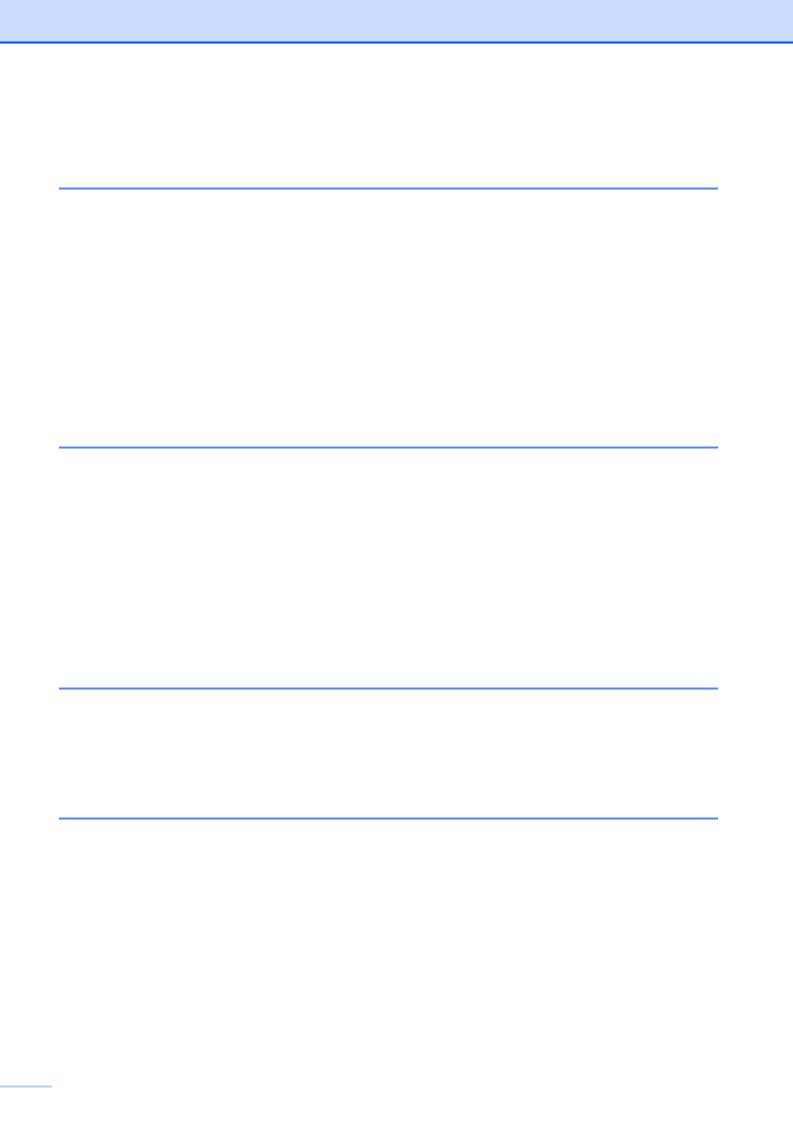
Table of Contents
(Basic User’s Guide)
1 |
General information |
1 |
|
Using the documentation ....................................................................................... |
1 |
|
Symbols and conventions used in the documentation .................................... |
1 |
|
Accessing Brother Utilities (Windows® 8) ............................................................. |
1 |
|
Accessing the Advanced User’s Guide and Software and |
|
|
Network User’s Guide......................................................................................... |
2 |
|
Viewing User’s Guides .................................................................................... |
2 |
|
How to access Guides for Advanced Features...................................................... |
4 |
|
Accessing Brother Support (Windows®)................................................................ |
4 |
|
Accessing Brother Support (Macintosh) ................................................................ |
5 |
|
Control panel overview .......................................................................................... |
6 |
|
Basic Operations ................................................................................................... |
8 |
2 |
Loading paper |
9 |
|
Loading paper and other print media..................................................................... |
9 |
|
Loading envelopes ........................................................................................ |
12 |
|
Unprintable area ............................................................................................ |
14 |
|
Paper settings...................................................................................................... |
15 |
|
Paper Type .................................................................................................... |
15 |
|
Paper Size ..................................................................................................... |
15 |
|
Acceptable paper and other print media.............................................................. |
15 |
|
Recommended print media ........................................................................... |
16 |
|
Handling and using print media ..................................................................... |
16 |
|
Choosing the right print media....................................................................... |
17 |
3 |
Loading documents |
18 |
|
How to load documents ....................................................................................... |
18 |
|
Using the ADF ............................................................................................... |
18 |
|
Using the scanner glass ................................................................................ |
19 |
|
Unscannable area ......................................................................................... |
20 |
4 |
Sending a fax |
21 |
|
How to send a fax ................................................................................................ |
21 |
|
Stop faxing..................................................................................................... |
22 |
|
Setting scanner glass size for faxing ............................................................. |
22 |
|
Color fax transmission ................................................................................... |
22 |
|
Canceling a fax in progress ........................................................................... |
22 |
|
Transmission Verification Report................................................................... |
23 |
 ii
ii

5 |
Receiving a fax |
24 |
|
Receive Modes .................................................................................................... |
24 |
|
Choose the correct Receive Mode ................................................................ |
24 |
|
Using Receive Modes.......................................................................................... |
26 |
|
Fax Only ........................................................................................................ |
26 |
|
Fax/Tel........................................................................................................... |
26 |
|
Manual........................................................................................................... |
26 |
|
External TAD ................................................................................................. |
26 |
|
Receive Mode settings ........................................................................................ |
27 |
|
Ring Delay ..................................................................................................... |
27 |
|
F/T Ring Time (Fax/Tel mode only)............................................................... |
27 |
|
Easy Receive................................................................................................. |
28 |
6 |
Telephone services and external devices |
29 |
|
Telephone services (Only available for some countries) ..................................... |
29 |
|
Voice Mail ...................................................................................................... |
29 |
|
Distinctive Ring.............................................................................................. |
30 |
|
Voice over Internet Protocol (VoIP) ............................................................... |
32 |
|
Connecting an external TAD (telephone answering device)................................ |
33 |
|
Connections................................................................................................... |
34 |
|
Recording an outgoing message (OGM) on the external TAD...................... |
34 |
|
Multi-line connections (PBX) ......................................................................... |
35 |
|
External and extension telephones...................................................................... |
35 |
|
Connecting an external telephone................................................................. |
35 |
|
Using external and extension telephones...................................................... |
36 |
|
Using a non-Brother cordless external telephone ......................................... |
36 |
|
Using remote codes....................................................................................... |
36 |
7 |
Dialing and storing numbers |
38 |
|
How to dial ........................................................................................................... |
38 |
|
Manual dialing ............................................................................................... |
38 |
|
Speed Dialing ................................................................................................ |
38 |
|
Fax Redial ..................................................................................................... |
38 |
|
Storing numbers .................................................................................................. |
39 |
|
Storing a pause ............................................................................................. |
39 |
|
Storing Speed Dial numbers.......................................................................... |
39 |
|
Changing and deleting Speed Dial numbers ................................................. |
40 |
8 |
Making copies |
41 |
|
How to copy ......................................................................................................... |
41 |
|
Stop copying.................................................................................................. |
41 |
|
Copy options........................................................................................................ |
42 |
|
Paper Type .................................................................................................... |
42 |
|
Paper Size ..................................................................................................... |
42 |
9 |
How to print from a computer |
43 |
|
Printing a document............................................................................................. |
43 |
iii 
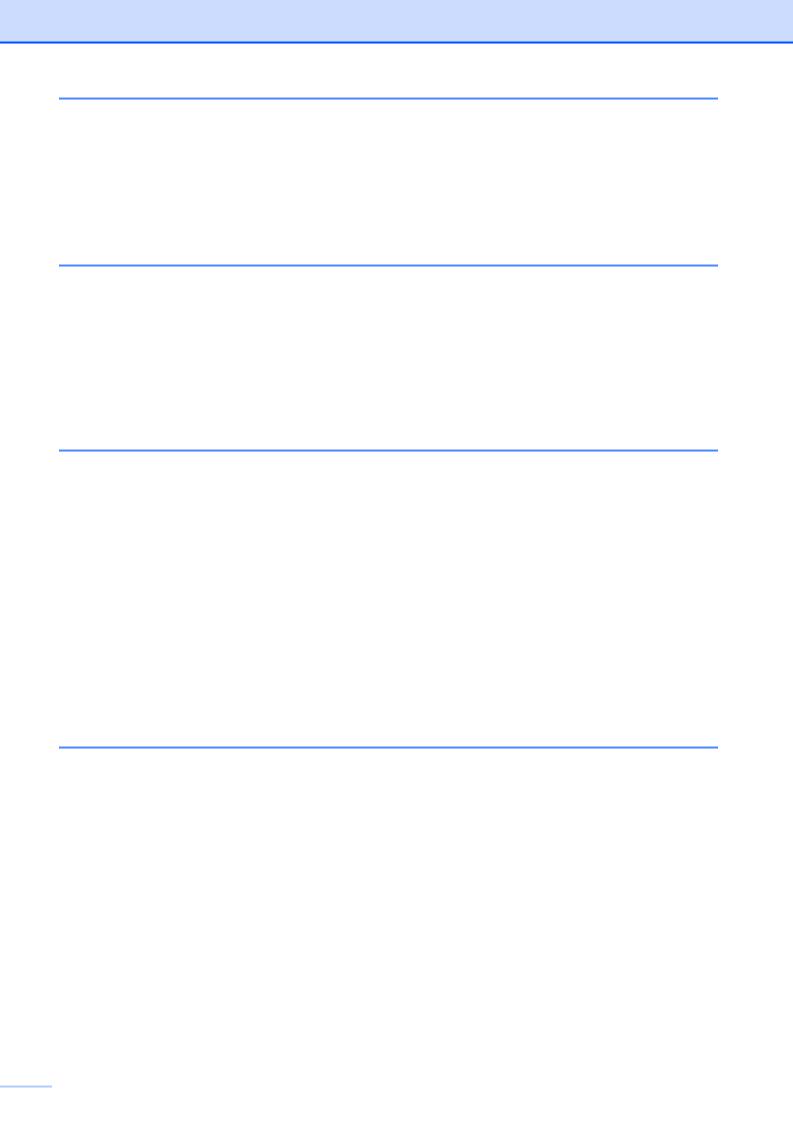
10 |
How to scan to a computer |
44 |
|
Before scanning................................................................................................... |
44 |
|
Scanning a document as a PDF file using ControlCenter4 (Windows®) ............. |
44 |
|
How to change the machine’s SCAN mode settings for PDF scanning using |
|
|
ControlCenter4 (Windows®) ............................................................................. |
48 |
|
How to scan a document as a PDF file using the control panel |
|
|
(Windows® and Macintosh) .............................................................................. |
50 |
A |
Routine maintenance |
51 |
|
Replacing the ink cartridges ................................................................................ |
51 |
|
Cleaning and checking the machine.................................................................... |
54 |
|
Cleaning the scanner..................................................................................... |
54 |
|
Cleaning the print head ................................................................................. |
55 |
|
Checking the print quality .............................................................................. |
55 |
|
Checking the print alignment ......................................................................... |
56 |
|
Setting the date and time..................................................................................... |
57 |
B |
Troubleshooting |
58 |
|
Identifying the problem ........................................................................................ |
58 |
|
Error and maintenance messages....................................................................... |
60 |
|
Transferring your faxes or Fax Journal report ............................................... |
67 |
|
Document jam .............................................................................................. |
68 |
|
Printer jam or paper jam ................................................................................ |
69 |
|
If you are having difficulty with your machine ...................................................... |
77 |
|
Dial Tone ...................................................................................................... |
88 |
|
Telephone line interference / VoIP ................................................................ |
88 |
|
Machine Information ............................................................................................ |
88 |
|
Checking the serial number........................................................................... |
88 |
|
Checking the firmware version ...................................................................... |
88 |
|
Reset functions.............................................................................................. |
89 |
|
How to reset the machine.............................................................................. |
89 |
C |
Menu and features tables |
90 |
|
Using the Menu tables ......................................................................................... |
90 |
|
Memory Storage .................................................................................................. |
90 |
|
Menu keys ........................................................................................................... |
91 |
|
Menu table ........................................................................................................... |
92 |
|
Features tables .................................................................................................. |
100 |
|
Entering Text ..................................................................................................... |
107 |
|
Inserting spaces ......................................................................................... |
107 |
|
Making corrections ...................................................................................... |
107 |
|
Repeating letters ......................................................................................... |
107 |
|
Special characters and symbols.................................................................. |
108 |
 iv
iv

D |
Specifications |
109 |
|
General.............................................................................................................. |
109 |
|
Print media......................................................................................................... |
111 |
|
Fax..................................................................................................................... |
112 |
|
Copy .................................................................................................................. |
113 |
|
Scanner ............................................................................................................. |
114 |
|
Printer ................................................................................................................ |
115 |
|
Interfaces ........................................................................................................... |
116 |
|
Network.............................................................................................................. |
116 |
|
Computer requirements ..................................................................................... |
117 |
|
Consumable items ............................................................................................. |
118 |
E |
Index |
119 |
v |
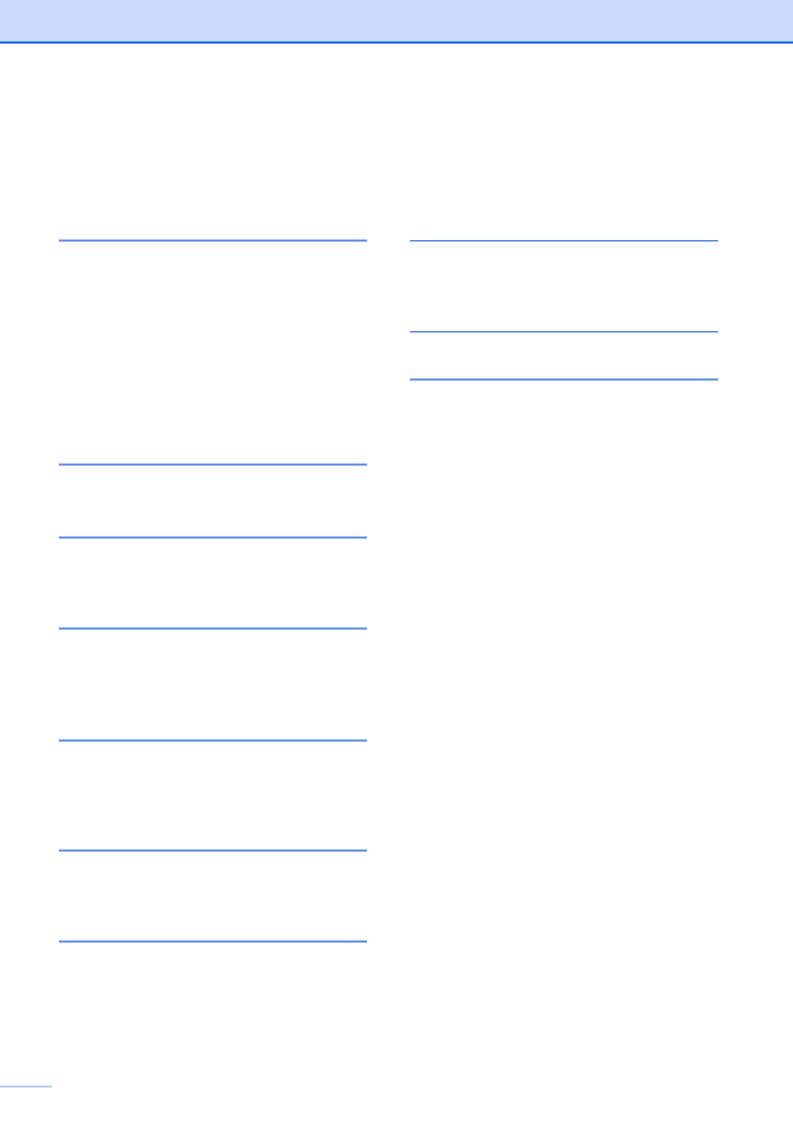
Table of Contents
(Advanced User’s Guide)
The Advanced User’s Guide explains the following features and operations. You can view the Advanced User’s Guide on the CD-ROM.
1 General setup
Memory Storage
Volume Settings (MFC model) Automatic Daylight Saving Time (MFC model)
Sleep Mode
Auto Power Off (DCP models) LCD
Mode Timer (MFC model)
2Security features (MFC model)
TX Lock
3 Sending a fax (MFC model)
Additional sending options
Additional sending operations
4 Receiving a fax (MFC model)
Memory Receive (Black & White only) Additional receiving operations
5Dialing and storing numbers (MFC model)
Voice operations
Additional dialing operations Additional ways to store numbers
A Routine maintenance
Cleaning and checking the machine Packing and shipping the machine
BGlossary
CIndex
6 Printing reports
Fax reports (MFC model) Reports
7 Making copies
Copy options
 vi
vi

 1 General information
1 General information
Using the documentation
Thank you for buying a Brother machine! Reading the documentation will help you make the most of your machine.
1
NOTE
Notes tell you how to respond to a situation that may arise or give tips about how the operation works with other features.
Electrical Hazard icons alert you to possible electrical shock.
Symbols and conventions used in the documentation
The following symbols and conventions are used throughout the documentation.
Bold Bold typeface identifies specific keys on the machine’s control panel and on the computer screen.
Italics Italicized typeface emphasizes an important point or refers you to a related topic.
Courier Text in Courier New font New identifies messages on the
LCD of the machine.
WARNING
WARNING indicates a potentially hazardous situation which, if not avoided, could result in death or serious injuries.
CAUTION
CAUTION indicates a potentially hazardous situation which, if not avoided, may result in minor or moderate injuries.
IMPORTANT
IMPORTANT indicates a potentially hazardous situation which, if not avoided, may result in damage to property or loss of product functionality.
Accessing Brother
Utilities (Windows® 8)
If you are using a PC or tablet running
Windows® 8, you can make your selections either by tapping the screen or by clicking with your mouse.
After the printer driver is installed,
(Brother Utilities) appears on both the Start screen and the desktop.
a Tap or click Brother Utilities either on the Start screen or the desktop.
1 |
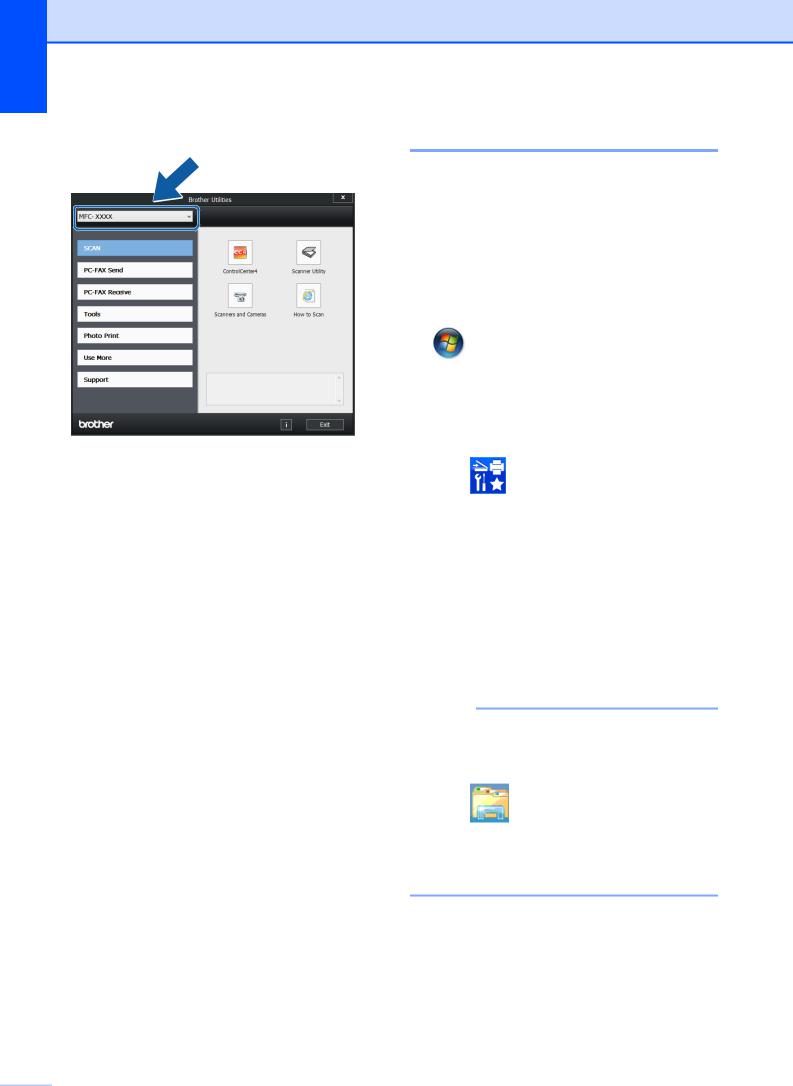
Chapter 1
b Select your machine.
c Choose the function you want to use.
Accessing the
Advanced User’s
Guide and Software
and Network User’s
Guide
This Basic User’s Guide does not contain all the information about the machine, such as how to use the advanced Fax, Copy, Printer, Scanner, PC-Fax, and Network features.
When you are ready to learn detailed information about these operations, read the
Advanced User’s Guide and Software and Network User’s Guide in HTML format that are on the CD-ROM.
Viewing User’s Guides
(Windows®)
Windows® XP/Windows Vista®/ Windows® 7/Windows Server® 2003/ Windows Server® 2008/
Windows Server® 2008 R2
To view the documentation, from
(Start), All Programs, select
Brother, MFC-XXXX (where XXXX is your model name) from the programs group, and then choose User’s Guides.
Windows® 8/Windows Server® 2012
Click |
(Brother Utilities), and then |
click the drop-down list and select your model name (if not already selected). Click Support in the left navigation bar, and then click User’s Guides.
If you have not installed the software, you can find the documentation on the CD-ROM by following the instructions:
a Turn on your PC. Insert the Brother CD-ROM into your CD-ROM drive.
NOTE
If the Brother screen does not appear, go to Computer (My Computer). (For
Windows® 8 and Windows Server® 2012:
Click |
(File Explorer) on the |
taskbar, and then go to Computer.)
Double-click the CD-ROM icon, and then double-click start.exe.
b If the model name screen appears, click your model name.
 2
2
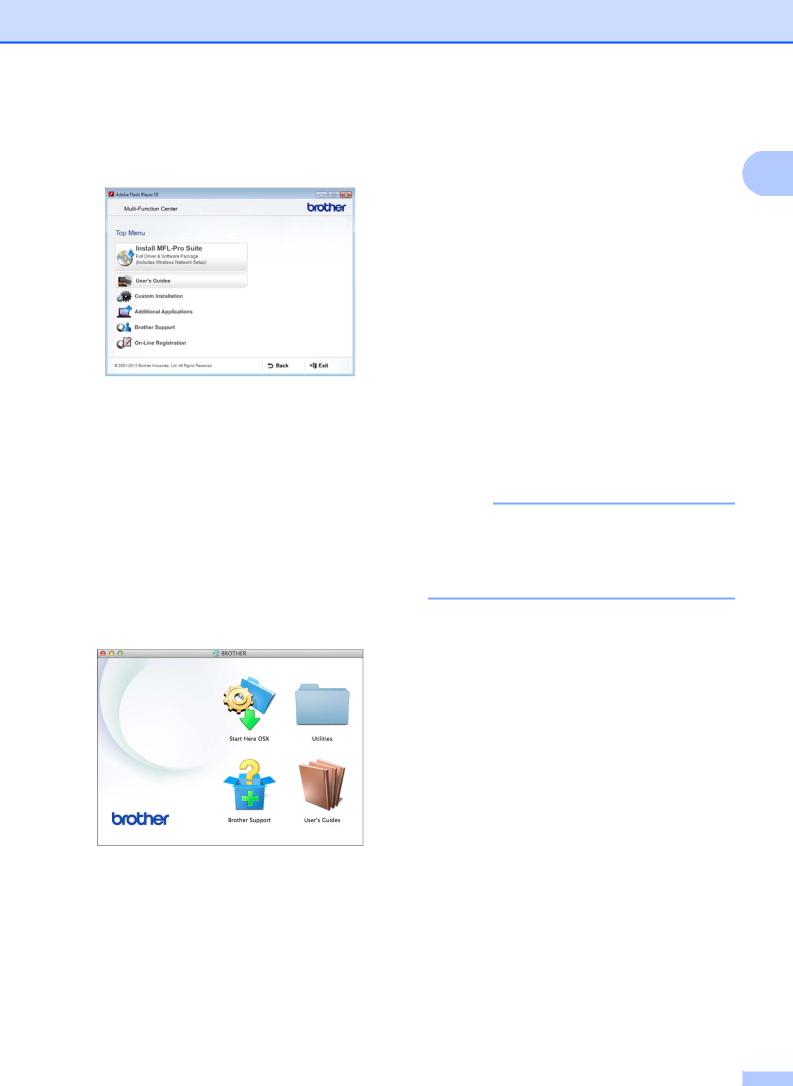
c If the language screen appears, click your language. The CD-ROM
Top Menu will appear.
d Click User’s Guides.
e Click PDF/HTML documents. If the country screen appears, choose your country. After the list of User’s Guides appears, choose the guide you want to read.
(Macintosh)
a Turn on your Macintosh. Insert the Brother CD-ROM into your CD-ROM drive. The following window will appear.
b Double-click the User’s Guides icon.
c Select your model and language if needed.
d Click User’s Guides. If the country screen appears, choose your country.
e After the list of User’s Guides appears, choose the Guide you want to read.
General information
How to find Scanning instructions
There are several ways you can scan documents. You can find the instructions as 1 follows:
Software and Network User’s Guide
Scan
ControlCenter
Nuance™ PaperPort™ 12SE How-to-Guides
(Windows®)
The complete Nuance™ PaperPort™ 12SE How-to-Guides can be viewed from the Help selection in the PaperPort™ 12SE application.
Presto! PageManager User’s Guide (Macintosh)
NOTE
Presto! PageManager is available as a download from http://nj.newsoft.com.tw/download/ brother/PM9SEInstaller_BR_multilang2.dmg
The complete Presto! PageManager User’s Guide can be viewed from the Help selection in the Presto! PageManager application.
How to find Network setup instructions
Your machine can be connected to a wireless network.
Basic setup instructions (See Quick Setup Guide.)
The wireless access point or router supports Wi-Fi Protected Setup™ or AOSS™
(See Quick Setup Guide.)
For more information about network setup, see Software and Network User’s Guide: Network.
3 |

Chapter 1
How to access Guides for Advanced Features
You can view and download these Guides from the Brother Solutions Center at: http://solutions.brother.com/.
Click Manuals on your model’s page to download the documentation.
AirPrint Guide
This Guide provides information for using AirPrint to print from OS X v10.7.x, 10.8.x and your iPhone, iPod touch, iPad, or other iOS device to your Brother machine without installing a printer driver.
Google Cloud Print Guide
This Guide provides details on how to use Google Cloud Print™ services for printing over the Internet.
Mobile Print/Scan Guide for Brother iPrint&Scan
This Guide provides useful information about printing from your mobile device and scanning from your Brother machine to your
mobile device when connected to a Wi-Fi® network.
Accessing Brother
Support (Windows®)
You can find all the contacts you will need, such as web support (Brother Solutions Center) on the CD-ROM.
Click Brother Support on the Top Menu. The following screen will appear:
To access our website (http://www.brother.com/), click
Brother Home Page.
For the latest news and product support information (http://solutions.brother.com/), click
Brother Solutions Center.
To visit our website for genuine Brother Supplies (http://www.brother.com/original/), click Supplies Information.
To access the Brother CreativeCenter (http://www.brother.com/creativecenter/) for FREE photo projects and printable downloads, click
Brother CreativeCenter.
To return to the Top Menu, click Back or if you are finished, click Exit.
 4
4
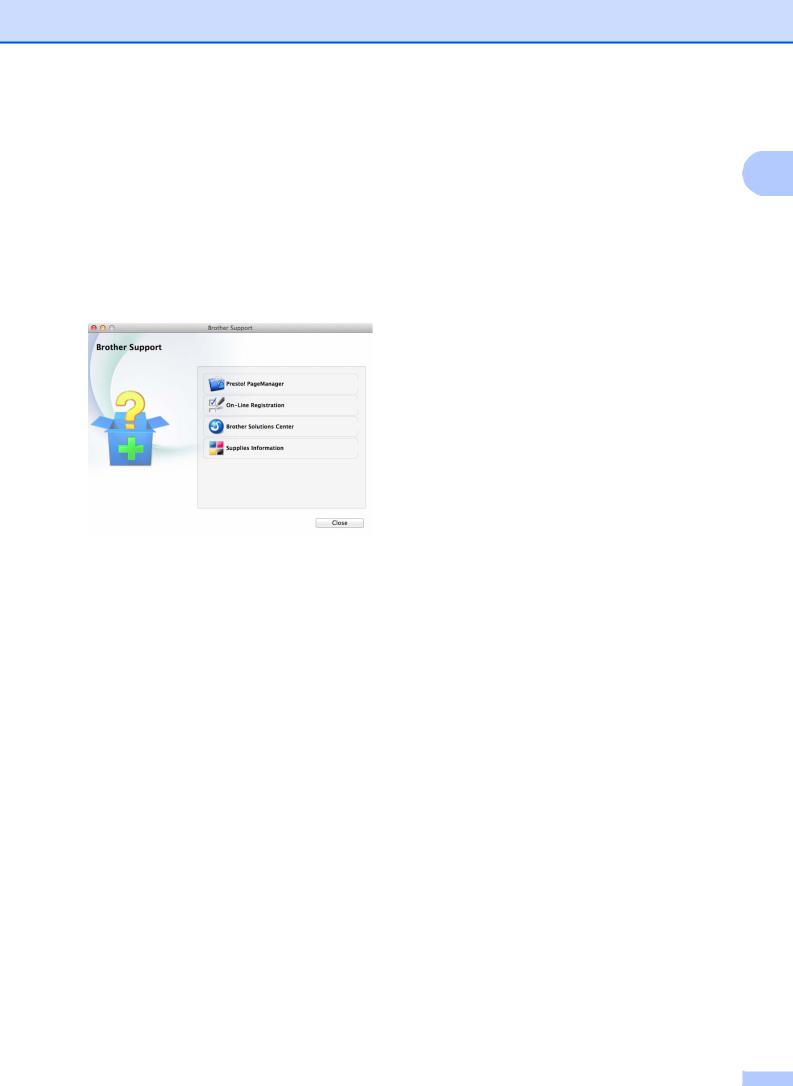
Accessing Brother
Support (Macintosh)
You can find all the contacts you will need, such as web support (Brother Solutions Center) on the CD-ROM.
Double-click the Brother Support icon. The following screen will appear:
To download and install Presto! PageManager, click
Presto! PageManager.
To register your machine from the Brother Product Registration Page (http://www.brother.com/registration/), click On-Line Registration.
For the latest news and product support information (http://solutions.brother.com/), click
Brother Solutions Center.
To visit our website for genuine Brother Supplies (http://www.brother.com/original/), click
Supplies Information.
General information
1
5 |
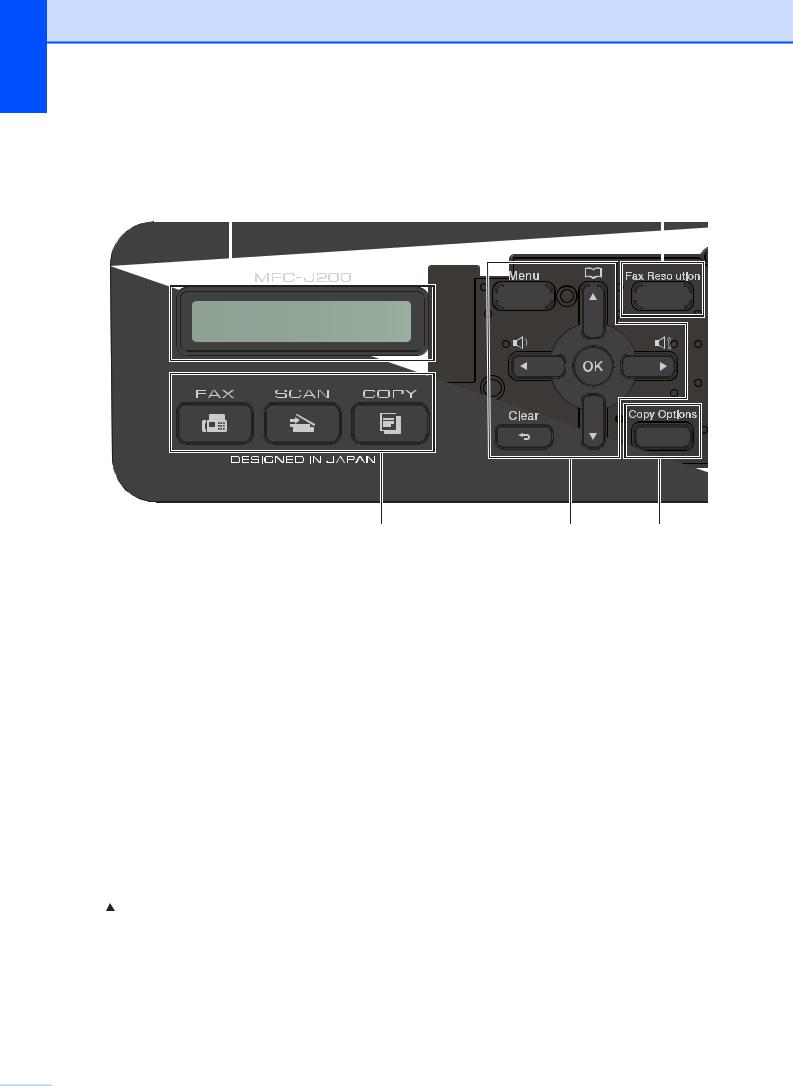
Chapter 1
Control panel overview
1 |
|
|
|
|
|
|
|
|
|
|
|
10 |
|
|
|
|||
|
|
|
|
|
|
|
|
|
|
|
|
|
|
|
|
|
|
|
|
|
|
|
|
|
|
|
|
|
|
|
|
|
|
|
|
|
|
|
|
|
|
|
|
|
|
|
|
|
|
|
|
|
|
|
|
|
|
|
|
|
|
|
|
|
|
|
|
|
|
|
|
|
|
|
|
|
|
|
|
|
|
|
|
|
|
|
|
|
|
|
|
|
|
|
|
|
|
|
|
|
|
|
|
|
|
|
|
|
|
|
|
|
|
|
|
|
|
|
|
|
|
|
|
|
|
|
|
|
|
|
|
|
|
|
|
|
|
|
|
|
|
|
|
|
|
|
|
|
|
|
|
01/01 19:45 Fax
2 |
3 |
4 |
1 LCD (Liquid Crystal Display) |
a or b |
The LCD displays messages to help you set up and use your machine.
Press a or b to scroll through the menus and options.
2 Mode keys:
 FAX
FAX
Lets you access Fax mode.
 SCAN
SCAN
Lets you access Scan mode.
 COPY
COPY
Lets you access Copy mode.
3 Menu keys:
 d c
d c 

While the machine is idle, you can press these keys to adjust the ring volume.

Menu
Access the main menu.
Clear
Press to delete characters or to go back to the previous menu level.
OK
Lets you choose a setting.
4Copy Options
Lets you temporarily change the copy settings when in copy mode.
5Telephone keys:
Redial/Pause
Redials the last number called. It also inserts a pause when dialing numbers.
Hook
Press to store Speed Dial and
Group numbers in the machine’s memory.
Lets you store, look up, and dial numbers that are stored in the memory.
d or c
Press d or c to move the selected area left or right on the LCD.
Press before dialing when you want to listen to make sure a fax machine answers and then press Black Start or Color Start.
Also, press this key after picking up the handset of the external telephone during the F/T pseudo/double-ring.
 6
6

General information
1
|
|
|
|
9 |
|
|
|
|
|
|
|
|
|
|
|
|
8 |
7 |
|
|
|
||||||||||||
|
|
|
|
|
|
|
|
|
|
|
|
|
|
|
|
|
|
|
|
|
|
|
|
|
|
|
|
|
|
|
|
|
|
|
|
|
|
|
|
|
|
|
|
|
|
|
|
|
|
|
|
|
|
|
|
|
|
|
|
|
|
|
|
|
|
|
|
|
|
|
|
|
|
|
|
|
|
|
|
|
|
|
|
|
|
|
|
|
|
|
|
|
|
|
|
|
|
|
|
|
|
|
|
|
|
|
|
|
|
|
|
|
|
|
|
|
|
|
|
|
|
|
|
|
|
|
|
|
|
|
|
|
|
|
|
|
|
|
|
|
|
|
|
|
|
|
|
|
|
|
|
|
|
|
|
|
|
|
|
|
|
|
|
|
|
|
|
|
|
|
|
|
|
|
|
|
|
|
|
|
|
|
|
|
|
|
|
|
|
|
|
|
|
|
|
|
|
|
|
|
|
|
|
|
|
|
|
|
|
|
|
|
|
|
|
|
|
|
|
|
|
|
|
|
|
|
|
|
|
|
|
|
|
|
|
|
|
|
|
|
|
|
|
|
|
|
|
|
|
|
|
|
|
|
|
|
|
|
|
|
|
|
|
|
|
|
|
|
|
|
|
|
|
|
|
|
|
|
|
|
|
|
|
|
|
|
|
|
|
|
|
|
|
|
|
|
|
|
|
|
|
|
|
|
|
|
|
|
|
|
|
|
|
|
|
|
|
|
|
|
|
|
|
|
|
|
|
|
|
|
|
|
|
|
|
|
|
|
|
|
|
|
|
|
|
|
|
|
|
|
|
|
|
|
|
|
|
|
|
|
|
|
|
|
|
|
|
|
|
|
|
|
|
|
|
|
|
|
|
|
|
|
|
|
|
|
|
|
|
|
|
|
|
|
|
|
|
|
|
|
|
|
|
|
|
|
|
|
|
|
|
|
|
|
|
|
|
|
|
|
|
|
|
|
|
|
|
|
|
|
|
|
|
|
|
|
|
|
|
|
|
|
|
|
|
|
|
|
|
|
|
|
|
|
|
|
|
|
|
|
|
|
|
|
|
|
|
|
|
|
|
|
|
|
|
|
|
|
|
|
|
|
|
|
|
|
|
|
|
|
|
|
|
|
|
|
|
|
|
|
|
|
|
|
|
|
|
|
|
|
|
|
|
|
|
|
|
|
|
|
|
|
|
|
|
|
|
|
|
|
|
|
|
|
|
|
|
|
|
|
|
|
|
|
|
|
|
|
|
|
|
|
|
|
|
|
|
|
|
|
|
|
|
|
|
|
|
|
|
|
|
|
|
|
|
|
|
|
|
|
|
|
|
|
|
|
|
|
|
|
|
|
|
|
|
|
|
|
|
|
|
|
|
|
|
|
|
|
|
|
|
|
|
|
|
|
|
|
|
|
|
|
|
|
|
|
|
|
|
|
|
|
|
|
|
|
|
|
|
|
|
|
|
|
|
|
|
|
|
|
|
|
|
|
|
|
|
|
|
|
|
|
|
|
|
|
|
|
|
|
|
|
|
|
|
|
|
|
|
|
|
|
|
|
|
|
|
|
|
|
|
|
|
|
|
|
|
|
|
|
|
|
|
|
|
|
|
|
|
|
|
|
|
|
|
|
|
|
|
|
|
|
|
|
|
|
|
|
|
|
|
|
|
|
|
|
|
|
|
|
|
|
|
|
|
|
|
5 |
6 |
6Start keys:
 Black Start
Black Start
Lets you start sending faxes or making copies in black & white. Also lets you start a scanning operation (in color or black & white depending on the scan setting in the ControlCenter software).
 Color Start
Color Start
Lets you start sending faxes or making copies in full color. Also lets you start a scanning operation (in color or black & white, depending on the scan setting in the ControlCenter software).
7 Power On/Off
Power On/Off
Press  to turn on the machine. Press and hold down
to turn on the machine. Press and hold down  to turn off the
to turn off the
If you turn off the machine using |
, it will still |
periodically clean the print head to maintain print quality. To prolong print head life, provide better ink efficiency, and maintain print quality, keep your machine connected to the power at all times.
8 Stop/Exit
Stop/Exit
Stops an operation or exits the menu.
9Dial Pad
Use these keys to dial telephone and fax numbers and as a keyboard for entering information into the machine.
10Fax Resolution
Lets you temporarily change the resolution when sending a fax.
machine. The LCD displays Shutting Down and will stay on for a few seconds before turning itself off.
If you have connected an external telephone or TAD, it is always available.
7 |
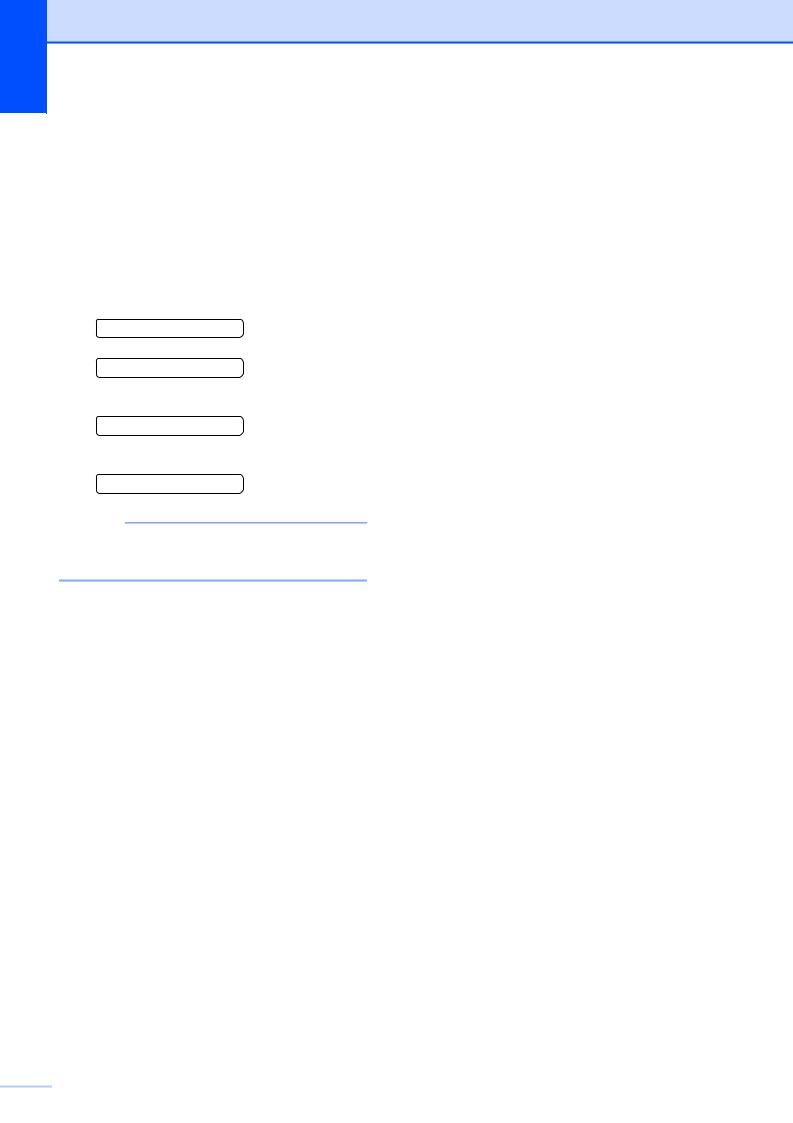
Chapter 1
Basic Operations
The following steps show how to change a setting in the machine. In this example, the Receive Mode setting is changed from
Fax Only to Fax/Tel.
a b
c
d
Press  (FAX).
(FAX).
Press Menu, 3, 1, 1.
Fax Only
Select ab & OK
Press a or b to choose Fax/Tel.
Fax/Tel
Press OK.
Accepted
NOTE
Press Clear if you want to go back to the previous level.
e Press Stop/Exit.
 8
8
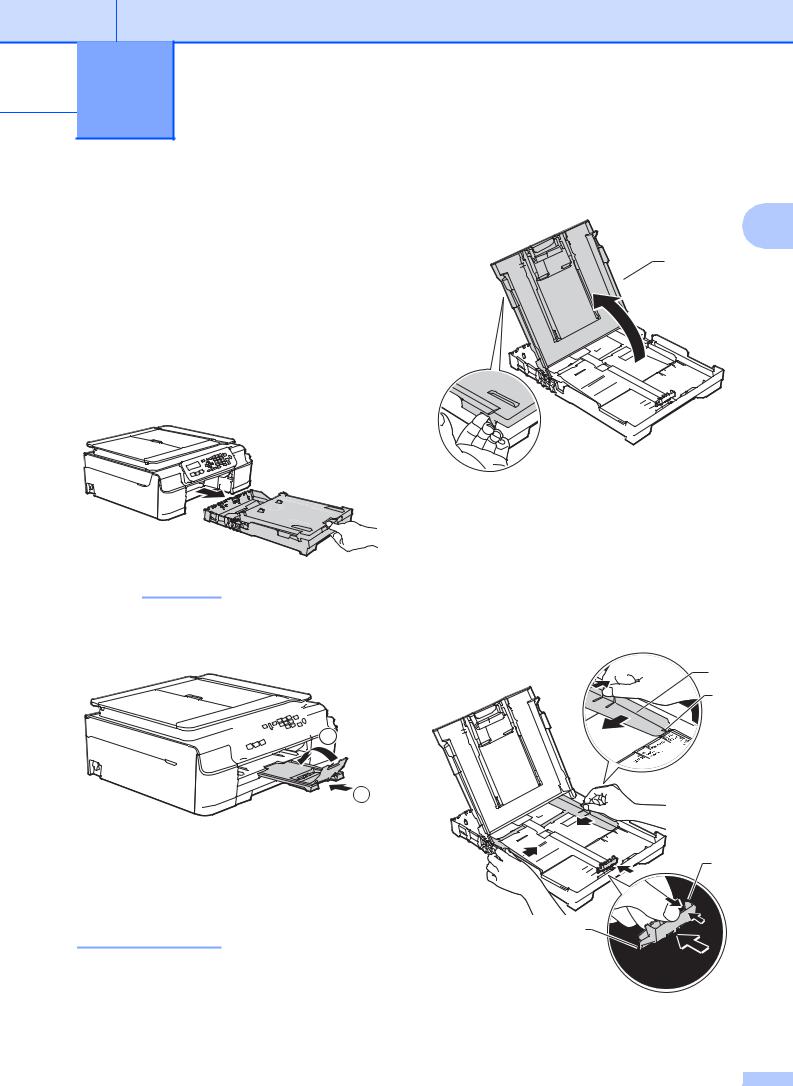
 2 Loading paper
2 Loading paper
Loading paper and other print media
Load only one size of paper and one type of paper in the paper tray at a time.
(For more information about paper size, weight and thickness, see Choosing the right print media on page 17.)
a Pull the paper tray completely out of the machine.
NOTE
•If the paper support flap (1) is open, close it, and then close the paper support (2).






 1
1
2
•When you load a different paper size in the tray, you will need to change the Paper Size setting in the machine at the same time.
(See Paper Size on page 15.)
b Lift the output paper tray cover (1).
2
1
c Gently press and slide the paper width guides (1) and then the paper length guide (2) to fit the paper size.
Make sure that the triangular marks (3) on the paper width guides (1) and paper length guide (2) line up with the marks for the paper size you are using.



 1
1
3
2
3
9 |
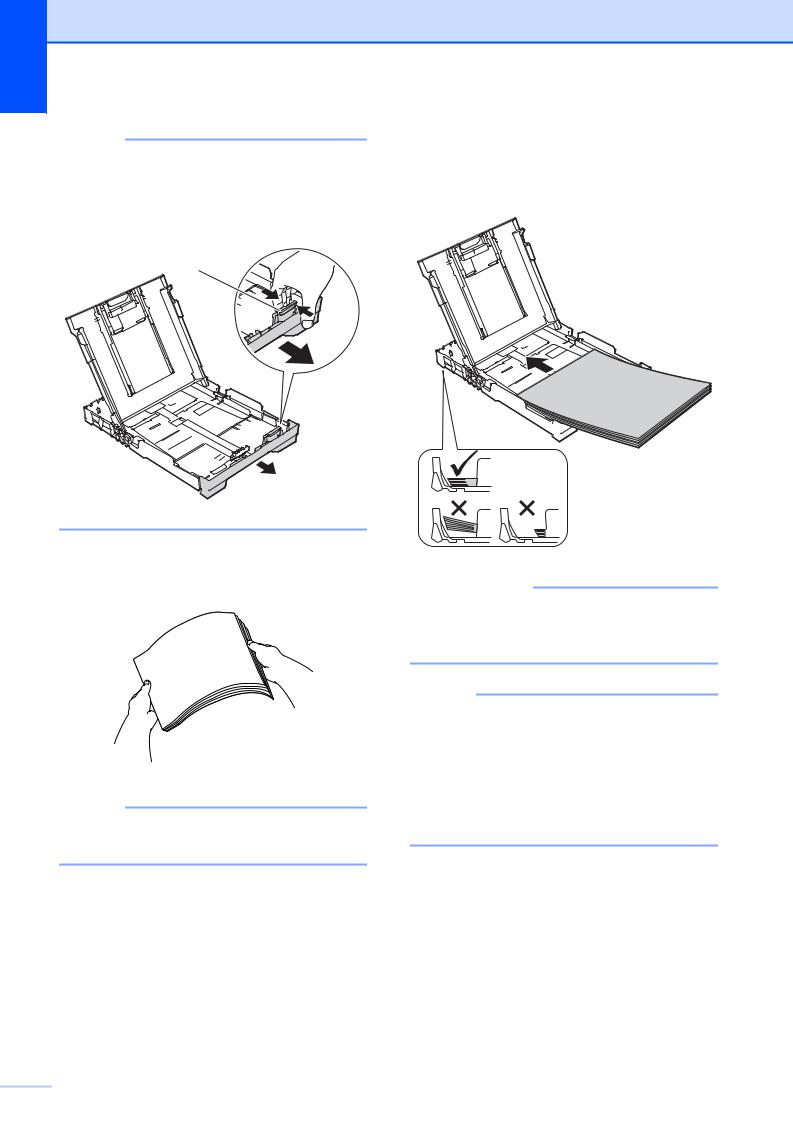
Chapter 2
NOTE
When you are using Legal size paper, press and hold the universal guide release button (1) as you slide out the front of the paper tray.
1
d Fan the stack of paper well to avoid paper jams and misfeeds.
NOTE
Always make sure that the paper is not curled or wrinkled.
e Gently put the paper into the paper tray printing surface face down and top edge in first.
Check that the paper is flat in the tray.
IMPORTANT
Be careful not to push the paper in too far; it may lift at the back of the tray and cause paper feed problems.
NOTE
If you want to add paper before the tray is empty, remove the paper from the tray and combine it with the paper you are adding. Always fan the stack of paper well before loading it in the tray. If you add paper without fanning the stack, the machine may feed multiple pages.
 10
10

f Gently adjust the paper width guides (1) to fit the paper.
Make sure the paper width guides lightly touch the sides of the paper.
1
g Close the output paper tray cover.
h Slowly and firmly push the paper tray completely into the machine.
Loading paper
i While holding the paper tray in place, pull out the paper support (1) until it locks into place, and then unfold the paper support flap (2).
2

 2
2
1
IMPORTANT
DO NOT use the paper support flap when printing on Legal size paper.
11 
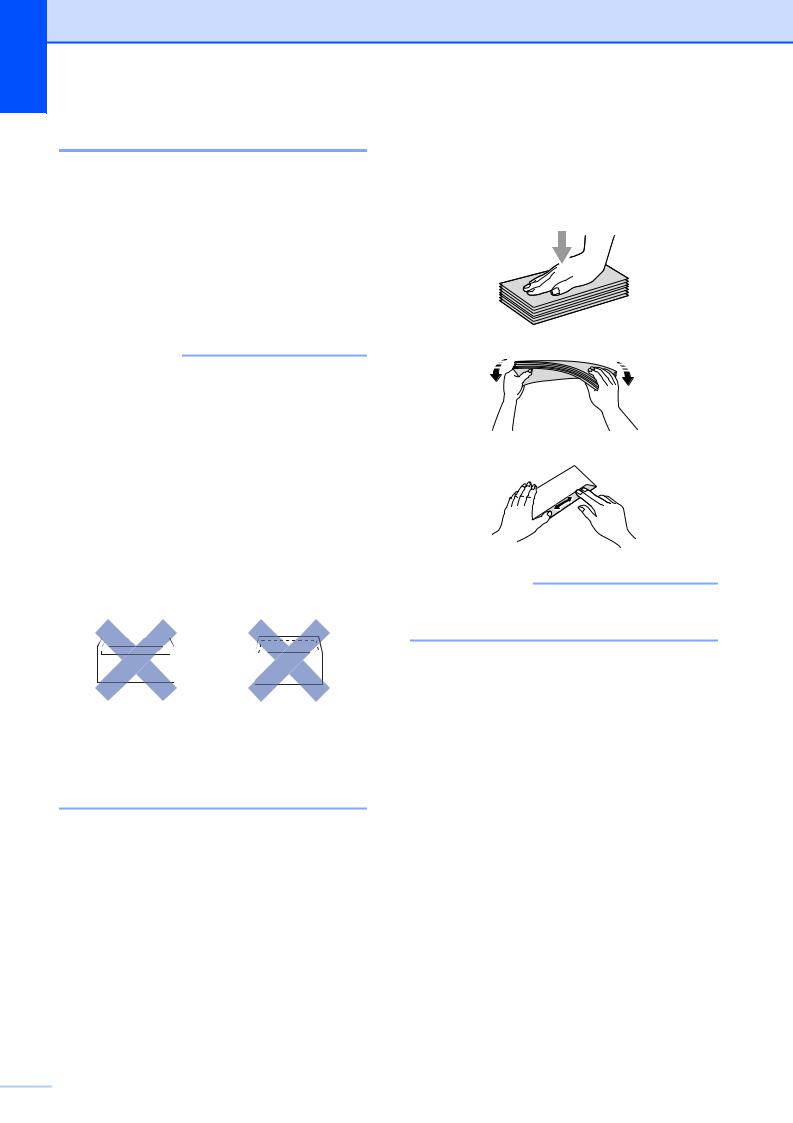
Chapter 2
Loading envelopes
About envelopes
Use envelopes that weigh from 20 to 25 lb (80 to 95 g/m2).
Some envelopes require you to make margin settings in the application you are using. Make sure you do a test print first before printing multiple envelopes.
IMPORTANT
DO NOT use the following types of envelopes, as they will not feed correctly:
•That are of a baggy construction.
•That have windows.
•That are embossed (have raised writing on them).
•That have clasps or staples.
•That are pre-printed on the inside.
Glue |
Double flaps |
||||
|
|
|
|
|
|
|
|
|
|
|
|
|
|
|
|
|
|
|
|
|
|
|
|
Occasionally you may experience paper feed problems caused by the thickness, size and flap shape of the envelopes you are using.
Loading envelopes
a Before loading, press the corners and sides of envelopes to make them as flat as possible.
IMPORTANT
If envelopes are “double-feeding,” put one envelope in the paper tray at a time.
 12
12

b Put envelopes in the paper tray with the printing surface face down. If the envelope flaps are on the long edge, load the envelopes in the tray with the flap on the left, as shown in the illustration. Gently press and slide the paper width guides (1) and paper length guide (2) to fit the size of the envelopes.


 1
1
2
Loading paper
If you have problems printing on envelopes with the flap on the short edge, try the following:
a Open the envelope flap.
b Put the envelope into the paper tray with 2 the printing surface face down and the
flap positioned as shown in the illustration.
c Select Reverse Print (Windows®) or
Reverse page orientation (Macintosh) in the printer driver’s dialog box, and then adjust the size and margin in the application you are using.
For more information, see Software and Network User’s Guide: Reverse Print
(Windows®) or Reverse Print (Macintosh).
13 

Chapter 2
Unprintable area
The unprintable area depends on the settings in the application you are using. The figures show the unprintable areas on cut-sheet paper and envelopes. The machine can print in the shaded areas of cut-sheet paper only when the Borderless print feature is available and turned on.
For more information, see Software and Network User’s Guide: Print without a Border
(Windows®) or Print without a Border (Macintosh). |
|
|
|
|
|
|
|
|
|
|
|
|
|||||||||
Cut-Sheet Paper |
|
Envelopes |
|
|
|||||||||||||||||
|
1 |
|
|
|
|
1 |
|
|
|
|
|
||||||||||
|
2 |
|
|
|
|
|
|
4 |
|
2 |
|
|
|
|
|
|
|
|
|
|
4 |
|
|
|
|
|
|
|
|
|
|
|
|
|
|
|
|
|
|
||||
|
|
|
|
|
|
|
|
|
|
|
|
|
|
|
|
|
|
||||
|
|
|
|
|
|
|
|
|
|
|
|
|
|
|
|
|
|
||||
|
|
|
|
|
|
|
|
|
|
|
|
|
|
|
|
|
|
||||
|
|
|
|
|
|
|
|
|
|
|
|
|
|
|
|
|
|
||||
|
|
|
|
|
|
|
|
|
|
|
|
|
|
|
|
|
|
||||
|
|
|
|
|
|
|
|
|
|
|
|
|
|
|
|
|
|
||||
|
|
|
|
|
|
|
|
|
|
|
|
|
|
|
|
|
|
||||
|
|
|
|
|
|
|
|
|
|
|
|
|
|
|
|
|
|
|
|
||
|
|
|
|
|
|
|
|
|
|
|
|
|
|
|
|
|
|
|
|
|
|
|
|
|
|
|
|
|
|
|
|
|
|
|
|
|
|
|
|
|
|
|
|
|
|
|
|
|
|
|
|
|
|
|
|
|
|
|
|
|
|
|
|
|
|
|
|
|
|
|
|
|
|
|
|
|
|
|
|
|
|
|
|
|
|
|
|
|
|
|
|
|
|
|
|
|
|
|
|
|
|
|
|
|
|
|
|
||
|
3 |
|
|
|
|
|
|
|
|
|
|
|
|
|
|
|
|
||||
|
|
|
|
|
|
|
|
|
|
3 |
|
|
|
|
|
||||||
|
|
|
|
|
|
|
|
|
|
|
|
|
|
|
|
|
|
|
|
|
|
|
|
|
|
Top (1) |
|
Left (2) |
Bottom (3) |
Right (4) |
|||||||||||||
Cut-Sheet |
|
|
|
0.12 in. (3 mm) |
|
0.12 in. (3 mm) |
0.12 in. (3 mm) |
0.12 in. (3 mm) |
|||||||||||||
|
|
|
|
|
|
|
|
|
|
|
|
|
|
|
|
|
|
|
|
|
|
Envelopes |
|
|
|
0.87 in. (22 mm) |
|
0.12 in. (3 mm) |
0.87 in. (22 mm) |
0.12 in. (3 mm) |
|||||||||||||
|
|
|
|
|
|
|
|
|
|
|
|
|
|
|
|
|
|
|
|
|
|
NOTE
The Borderless print feature is not available for envelopes, 2-sided printing and some paper sizes, such as Legal and Executive. For more information, see Printer on page 115.
 14
14

Paper settings
Paper Type
To get the best print quality, set the machine for the type of paper you are using.
a Press Menu, 2, 2.
b Press a or b to choose Plain Paper,
Inkjet Paper, Brother BP71, Other Glossy or Transparency. Press OK.
c Press Stop/Exit.
NOTE
The machine ejects paper with the printed surface face up onto the paper tray at the front of the machine. When you use transparencies or glossy paper, remove each sheet at once to prevent smudging or paper jams.
Paper Size
You can use the following sizes of paper for copies: Letter, Legal, A4, A5, Executive and Photo (4" 6")/(10 15 cm). You can use the following sizes of paper for printing faxes:
Letter, Legal and A4. When you change the size of paper you load in the machine, you will need to change the Paper Size setting at the same time so your machine can fit an incoming fax on the page.
a Press Menu, 2, 3.
b Press a or b to choose Letter, Legal,
A4, A5, Executive or 4"x6". Press OK.
c Press Stop/Exit.
Loading paper
Acceptable paper and other print media
The print quality can be affected by the type |
2 |
of paper you use in the machine. |
To get the best print quality for the settings you have chosen, always set the Paper Type to match the type of paper you load.
You can use plain paper, inkjet paper (coated paper), glossy paper, transparencies and envelopes.
We recommend testing various paper types before buying large quantities.
For best results, use Brother paper.
When you print on inkjet paper (coated paper), transparencies and glossy paper, be sure to choose the correct print media in the printer driver’s Basic tab or the machine’s Paper Type setting.
(See Paper Type on page 15.)
When you print on Brother Photo paper, load one extra sheet of the same photo paper in the paper tray. An extra sheet has been included in the paper package for this purpose.
When using transparencies or photo paper, remove each sheet at once to prevent smudging or paper jams.
Avoid touching the printed surface of the paper immediately after printing; the surface may not be completely dry and may stain your fingers.
15 

Chapter 2
Recommended print media
To get the best print quality, we suggest using the Brother paper in the table.
We recommend using 3M Transparency Film when you print on transparencies.
Brother paper
Paper Type |
Item |
Premium Plus Glossy |
|
Photo |
|
Letter |
BP71GLTR |
4" 6" |
BP71GP20 |
|
|
Handling and using print media
Store paper in its original packaging and keep it sealed. Keep the paper flat and away from moisture, direct sunlight and heat.
Avoid touching the shiny (coated) side of the photo paper. Load photo paper with the shiny side facing down.
Avoid touching either side of the transparency paper because it absorbs water and perspiration easily, and this may cause decreased output quality. Transparencies designed for laser printers/copiers may stain your next document. Use only transparencies recommended for inkjet printing.
IMPORTANT
DO NOT use the following kinds of paper:
•Damaged, curled, wrinkled, or irregularly shaped
1 
1
10.08 in. (2 mm) or greater curl may cause jams to occur.
•Extremely shiny or highly textured
•Paper that cannot be arranged uniformly when stacked
•Paper made with a short grain
Paper capacity of the output paper tray cover
Up to 50 sheets of Letter, Legal or A4 20 lb (80 g/m2) paper.
Transparencies and photo paper must be picked up from the output paper tray cover one page at a time to avoid smudging.
 16
16

Loading paper
Choosing the right print media
Paper type and size for each operation
|
|
|
|
|
|
|
|
|
|
|
|
|
|
|
|
2 |
||
Paper Type |
|
Paper Size |
|
|
|
|
|
|
|
Usage |
|
|
|
|||||
|
|
|
|
|
|
|
|
|
|
|
|
|
Fax |
Copy |
Printer |
|
|
|
Cut-Sheet |
|
Letter |
|
8 |
1/2 |
11 in. (215.9 279.4 mm) |
Yes |
Yes |
Yes |
|
|
|
||||||
|
|
|
A4 |
|
8.3 |
|
11.7 in. (210 297 mm) |
Yes |
Yes |
Yes |
|
|
|
|||||
|
|
|
Legal |
|
8 |
1/2 |
14 in. (215.9 355.6 mm) |
Yes |
Yes |
Yes |
|
|
|
|||||
|
|
|
Executive |
7 |
1/4 |
10 1/2 in. (184 267 mm) |
– |
Yes |
Yes |
|
|
|
||||||
|
|
|
A5 |
|
5.8 |
|
8.3 in. (148 210 mm) |
– |
Yes |
Yes |
|
|
|
|||||
|
|
|
A6 |
|
4.1 |
|
5.8 in. (105 148 mm) |
– |
– |
Yes |
|
|
|
|||||
|
|
|
|
|
|
|
|
|
|
|
|
|
|
|
|
|
||
Cards |
|
Photo |
|
4 |
|
6 in. (10 15 cm) |
|
– |
Yes |
Yes |
|
|
|
|||||
|
|
|
Photo 2L |
5 |
|
7 in. (13 18 cm) |
|
– |
– |
Yes |
|
|
|
|||||
|
|
|
Index Card |
5 |
|
8 in. (127 203 mm) |
|
– |
– |
Yes |
|
|
|
|||||
|
|
|
|
|
|
|
|
|
|
|
|
|
|
|
||||
Envelopes |
|
C5 Envelope |
6.4 |
|
9 in. (162 229 mm) |
– |
– |
Yes |
|
|
|
|||||||
|
|
|
DL Envelope |
4.3 |
|
8.7 in. (110 220 mm) |
– |
– |
Yes |
|
|
|
||||||
|
|
|
Com-10 |
|
4 |
1/8 |
|
9 1/2 in. (105 241 mm) |
– |
– |
Yes |
|
|
|
||||
|
|
|
Monarch |
3 |
7/8 |
|
7 1/2 in. (98 191 mm) |
– |
– |
Yes |
|
|
|
|||||
|
|
|
|
|
|
|
|
|
|
|
|
|
|
|
|
|||
Transparencies |
Letter |
|
8 |
1/2 |
|
11 in. (215.9 279.4 mm) |
– |
Yes |
Yes |
|
|
|
||||||
|
|
|
A4 |
|
8.3 |
|
11.7 in. (210 297 mm) |
– |
Yes |
Yes |
|
|
|
|||||
|
|
|
Legal |
|
8 |
1/2 |
|
14 in. (215.9 355.6 mm) |
– |
Yes |
Yes |
|
|
|
||||
|
|
|
A5 |
|
5.8 |
|
8.3 in. (148 210 mm) |
– |
Yes |
Yes |
|
|
|
|||||
|
|
|
|
|
|
|
|
|
|
|
|
|||||||
Paper weight, thickness and capacity |
|
|
|
|
|
|
|
|||||||||||
|
|
|
|
|
|
|
|
|
|
|
|
|
|
|
|
|
|
|
Paper Type |
|
|
|
Weight |
|
|
|
|
|
|
Thickness |
|
No. of |
|
||||
|
|
|
|
|
|
|
|
|
|
|
|
|
|
|
sheets |
|
||
Cut-Sheet |
|
Plain Paper |
|
17 to 32 lb (64 to 120 g/m2) |
|
3 to 6 mil (0.08 to 0.15 mm) |
100 |
1 |
|
|
||||||||
|
|
Inkjet Paper |
|
17 to 53 lb (64 to 200 g/m2) |
|
3 to 10 mil (0.08 to 0.25 mm) |
20 |
|
|
|
||||||||
|
|
Glossy Paper |
|
Up to 58 lb (Up to 220 g/m2) |
|
Up to 10 mil (Up to 0.25 mm) |
20 2 |
|
|
|
||||||||
Cards |
|
Photo |
|
|
Up to 58 lb (Up to 220 g/m2) |
|
Up to 10 mil (Up to 0.25 mm) |
20 2 |
|
|
|
|||||||
|
|
(4" 6")/ |
|
|
|
|
|
|
|
|
|
|
|
|
|
|
|
|
|
|
(10 15 cm) |
|
|
|
|
|
|
|
|
|
|
|
|
|
|
|
|
|
|
|
|
|
|
|
|
|
|
|
||||||||
|
|
Index Card |
|
Up to 32 lb (Up to 120 g/m2) |
|
Up to 6 mil (Up to 0.15 mm) |
30 |
|
|
|
||||||||
Envelopes |
|
|
|
20 to 25 lb (80 to 95 g/m2) |
|
Up to 20 mil (Up to 0.52 mm) |
10 |
|
|
|
||||||||
Transparencies |
|
|
– |
|
|
|
|
|
|
– |
|
|
10 |
|
|
|
||
|
|
|
|
|
|
|
|
|
|
|
|
|
|
|
|
|
|
|
1Up to 100 sheets of plain paper 20 lb (80 g/m2).
2BP71 69 lb (260 g/m2) paper is especially designed for Brother inkjet machines.
17 
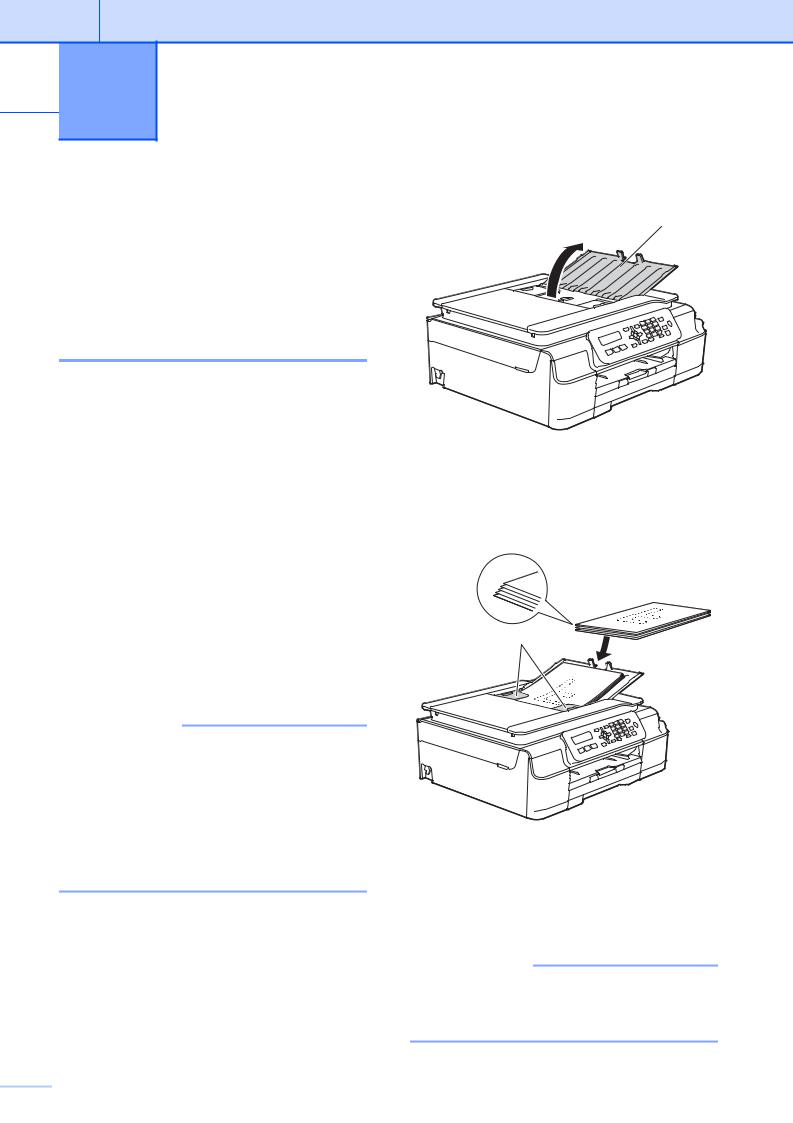
 3 Loading documents
3 Loading documents
How to load documents
You can send a fax, make copies, and scan from the ADF (automatic document feeder) and from the scanner glass.
Using the ADF
The ADF can hold up to 20 pages and feeds each sheet individually. Use paper that is within the sizes and weights shown in the table. Always fan the pages before placing them in the ADF.
Document sizes and weights
Length: |
5.8 to 14 in. |
|
(148 to 355.6 mm) |
Width: |
5.8 to 8.5 in. |
|
(148 to 215.9 mm) |
Weight: |
17 to 24 lb |
|
(64 to 90 g/m2) |
How to load documents
IMPORTANT
•DO NOT pull on the document while it is feeding.
•DO NOT use paper that is curled, wrinkled, folded, ripped, stapled, paper clipped, pasted or taped.
•DO NOT use cardboard, newspaper or fabric.
Make sure documents with ink or correction fluid are completely dry.
a Unfold the ADF Document Support (1).
1
b Fan the pages well.
c Adjust the paper guides (1) to fit the width of your document.
1
d Place your document, face down, top edge first in the ADF underneath the guides until the LCD displays
ADF Ready and you feel it touch the feed rollers.
IMPORTANT
DO NOT leave a thick document on the scanner glass. If you do this, the ADF may jam.
 18
18
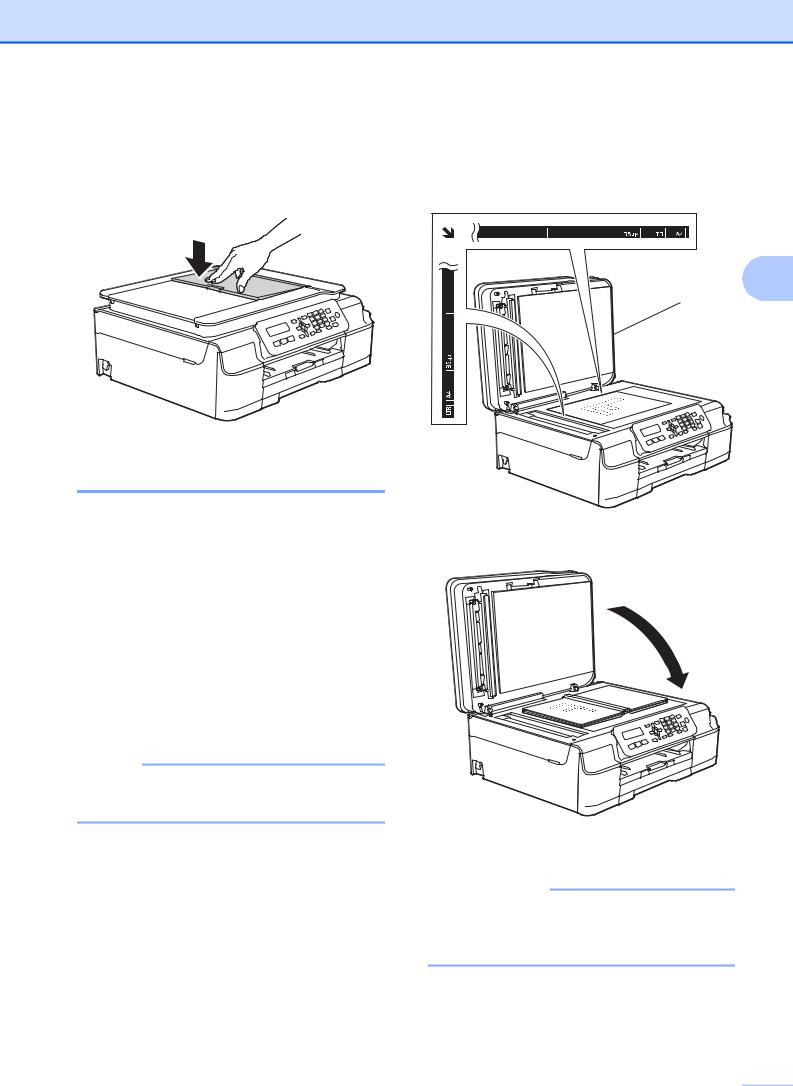
e After using the ADF, close the ADF Document Support. Push down on the upper-left portion of the ADF Document Support to close it completely.
Loading documents
b Using the document guidelines on the left and top, place the document
face down in the upper left corner of the scanner glass.
Using the scanner glass
You can use the scanner glass to fax, to copy or to scan individual pages or pages in a book.
Document sizes supported
Length: |
Up to 11.7 in. (297 mm) |
Width: |
Up to 8.5 in. (215.9 mm) |
Weight: |
Up to 4.4 lb (2 kg) |
|
|
How to load documents
NOTE
To use the scanner glass, the ADF must be empty.
a Lift the document cover.
3
1
1 document cover
c Close the document cover.
IMPORTANT
If you are scanning a book or thick document, DO NOT slam the cover down or press on it.
19 

Chapter 3
Unscannable area
The unscannable area depends on the settings in the application you are using. This figure shows the unscannable areas.
1
2 

 4
4
3
Usage |
Document |
Top (1) |
Left (2) |
|
Size |
Bottom (3) |
Right (4) |
|
|
||
Fax |
Letter |
0.12 in. |
0.16 in. |
|
|
(3 mm) |
(4 mm) |
|
Legal |
||
|
|
|
|
|
|
|
|
|
A4 |
|
0.12 in. 1 |
|
|
|
(3 mm) |
|
|
|
|
Copy |
All paper |
0.12 in. |
0.12 in. |
|
sizes |
(3 mm) |
(3 mm) |
|
|
|
|
Scan |
|
0.04 in. |
0.04 in. |
|
|
(1 mm) |
(1 mm) |
|
|
|
|
1The unscannable area is 0.04 in. (1 mm) when you use the ADF.
 20
20

 4 Sending a fax
4 Sending a fax
How to send a fax
a Do one of the following to load your document:
Place the document face down in the ADF. (See Using the ADF
on page 18.)
Load your document face down on the scanner glass. (See Using the scanner glass on page 19.)
NOTE
•To send color faxes with multiple pages, use the ADF.
•If you send a black & white fax from the ADF while the memory is full, it will be sent in real time.
•You can use the scanner glass to fax pages of a book one at a time. The document can be up to Letter or A4 size.
•Since you can only scan one page at a time, it is easier to use the ADF if you are sending a multiple-page document.
b Press  (FAX).
(FAX).
c You can change the following fax-sending settings.
(Basic User’s Guide)
For information about changing the following fax-sending settings, see pages 22 to 23.
Glass Scan Size |
4 |
|
Color Fax Transmission |
||
|
||
Transmission Verification Report |
|
|
(Setup) |
|
(Advanced User’s Guide)
For more advanced fax-sending operations and settings
(See Advanced User’s Guide: Sending a fax (MFC model).)
Contrast
Fax Resolution
Faxing at the end of a call
Broadcasting
Real Time Transmission
Overseas Mode
Canceling Waiting Jobs
d Enter the fax number using the dial pad, Speed Dial or Search.
e Press Black Start or Color Start.
Faxing from the ADF
The machine starts scanning and sending the document.
Faxing from the scanner glass
If you pressed Black Start, the machine starts scanning the first page. Go to step f.
If you pressed Color Start, the machine starts dialing and sending the document.
21 
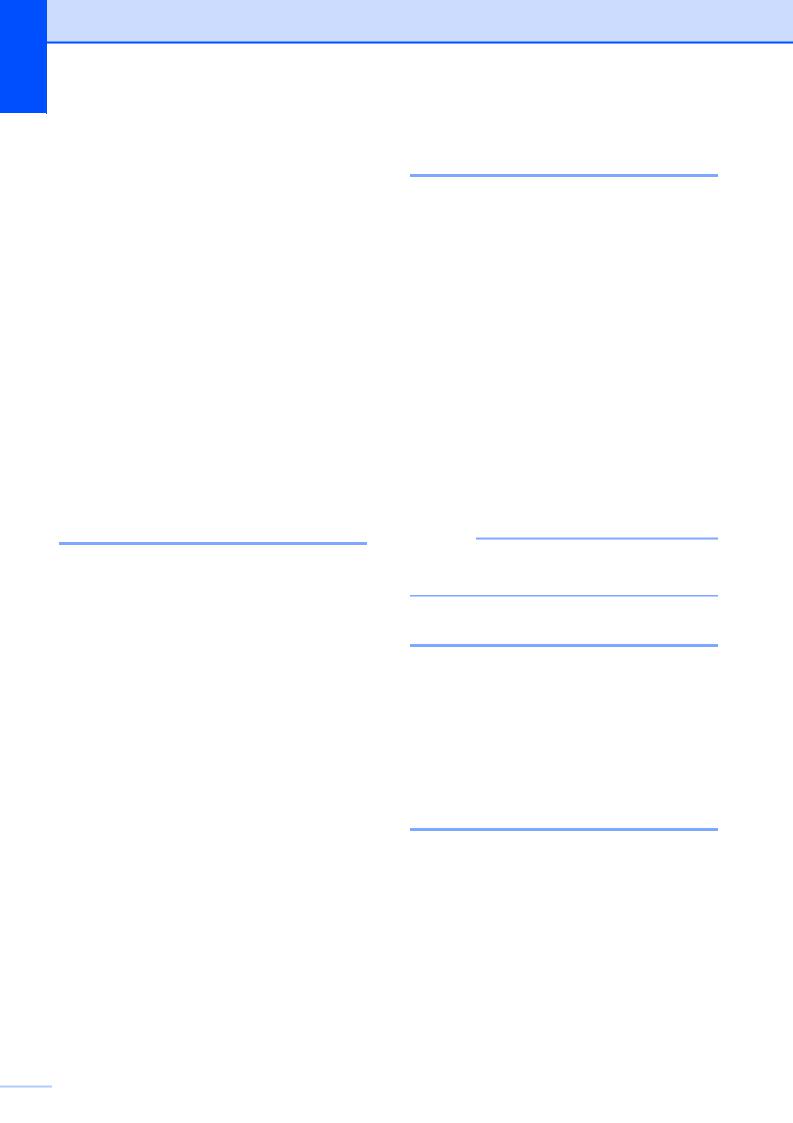
Chapter 4
f When the LCD asks you Next Page?, do one of the following:
To send a single page, press 2 to choose No(Dial) (or press
Black Start again).
The machine starts sending the document.
To send more than one page, press 1 to choose Yes and go to step g.
g Place the next page on the scanner glass.
Press OK.
The machine starts scanning the page. (Repeat steps f and g for each additional page.)
h After all the pages have been scanned, press 2 or Black Start to start.
Stop faxing
To stop faxing, press Stop/Exit.
Setting scanner glass size for faxing
When documents are A4 size, you need to set the Scan Size to A4. If you do not, the bottom portion of the faxes will be missing.
a Load your document. b Press  (FAX). c Press Menu, 3, 2, 0.
(FAX). c Press Menu, 3, 2, 0.
d Press a or b to choose Letter or A4. Press OK.
e Press Stop/Exit.
f Enter the fax number.
g Press Black Start or Color Start.
NOTE
This setting is only available for sending documents from the scanner glass.
Color fax transmission
Your machine can send a color fax to machines that support this feature.
Color faxes cannot be stored in the machine’s memory. When you send a color fax, the machine will send it in real time (even if
Real Time TX is set to Off).
Canceling a fax in progress
If you want to cancel a fax while the machine is scanning, dialing or sending, press
Stop/Exit.
 22
22
